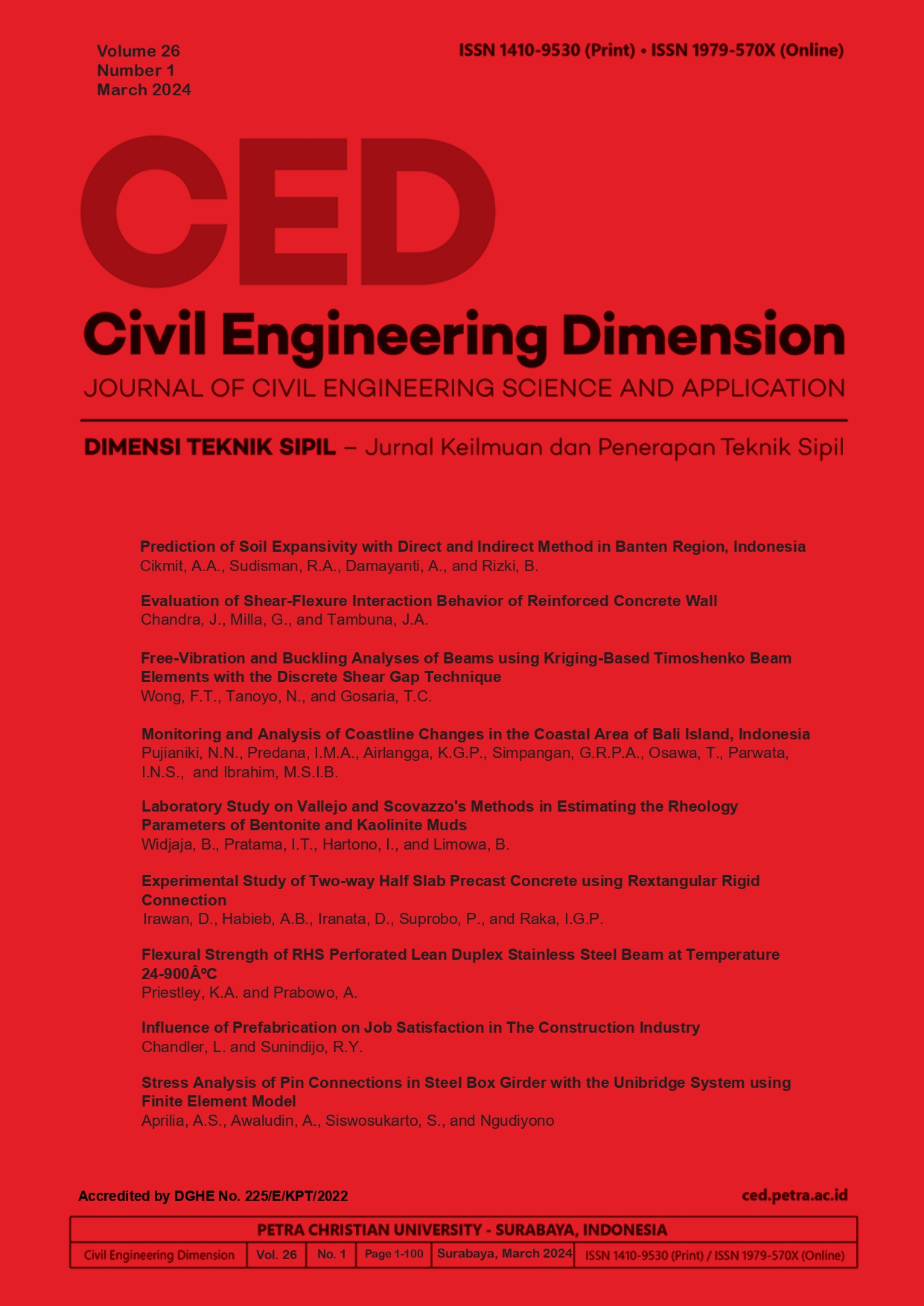Free-Vibration and Buckling Analyses of Beams using Kriging-Based Timoshenko Beam Elements with the Discrete Shear Gap Technique
DOI:
https://doi.org/10.9744/ced.26.1.21-31Keywords:
Kriging-based Timoshenko beam element, discrete shear gap, free vibration, bifurcation buckling, natural frequency, critical loadAbstract
A family of locking-free Kriging-based Timoshenko beam elements with a new implementation of the discrete shear gap technique was recently developed (referred to as K-beam-DSG1 elements). Performance of the K-beam-DSG1 elements has been shown to be very satisfactory in the linear static analysis of beams for a wide variety of thicknesses. This paper presents further development of the K-beam-DSG1 elements to free vibration and bifurcation buckling analyses of prismatic and non-prismatic beams. Consistent Kriging-based mass matrices are used for free vibration analysis and similarly, consistent Kriging-based geometric stiffness matrices are used for buckling analysis. The results show that for most of the cases, the K-beam-DGS1 elements yield remarkably accurate natural frequencies and critical compressive loads using a reasonable number of elements to discretize the beam. For an axially functionally graded fixed-fixed supported beam, however, the elements fail to predict the critical load accurately.
References
Wong, F.T. and Kanok-Nukulchai, W., On the Convergence of the Kriging-Based Finite Element Method, International Journal of Computational Methods, 6(1), 2009, doi: 10.1142/S0219876209001784.
Wong, F.T. and Kanok-Nukulchai, W., Kriging Based Finite Element Method: Element-By-Element Kriging Interpolation, Civil Engineering Dimension, 11(1), 2009, pp. 15–22, doi: 10.9744/ced.11.1.pp.%2015-22.
Kanok-Nukulchai, W., Wong, F.T., and Sommanawat, W., Generalization of FEM using Node-Based Shape Functions, Civil Engineering Dimension, 17(3), 2015, pp. 152–157, doi: 10.9744/CED.
Wong, F.T. and Kanok-Nukulchai, W., On Alleviation of Shear Locking in the Kriging-Based Finite Element Method, in Proceedings of International Civil Engineering Conference “Towards Sustainable Engineering Practice,” 2006, pp. 39–47.
Wong, F.T., Kriging-based Finite Element Method for Analyses of Plates and Shells, Asian Institute of Technology, Pathumthani, 2009.
Wong, F.T. and Syamsoeyadi, H., Kriging-based Timoshenko Beam Element for Static and Free Vibration Analyses, Civil Engineering Dimension, 13(1), 2011, pp. 42–49, doi: 10.9744/ced.13.1.42-49.
Bletzinger, K.-U., Bischoff, M., and Ramm, E., A Unified Approach for Shear-Locking-Free Triangular and Rectangular Shell Finite Elements, Computers & Structures, 75(3), Apr. 2000, pp. 321–334, doi: 10.1016/S0045-7949(99)00140-6.
Wong, F.T., Sulistio, A., and Syamsoeyadi, H., Kriging-based Timoshenko Beam Elements with the Discrete Shear Gap Technique, International Journal of Computational Methods, 15(7), 2018, pp. 1850064-1–27, doi: 10.1142/S0219876218500640.
Wong, F.T.., Santoso, S. W., and Sutrisno, M., Locking-free Kriging-based Timoshenko Beam Elements using an Improved Implementation of the Discrete Shear Gap Technique, Civil Engineering Dimension, 24(1), 2022, pp. 11–18, doi: 10.9744/ced.24.1.11-18.
Shahba, A., Attarnejad, R., Marvi, M.T., and Hajilar, S., Free Vibration and Stability Analysis of Axially Functionally Graded Tapered Timoshenko Beams with Classical and Non-Classical Boundary Conditions, Composite Part B: Engineering, 42(4), 2011, pp. 801–808, doi: 10.1016/j.compositesb.2011.01.017.
Clough, R.W. and Penzien, J., Dynamics of Structures. Berkeley, 2003.
Kosmatka, J.B., An Improved Two-Node Finite Element for Stability and Natural Frequencies of Axial-Loaded Timoshenko Beams, Computers & Structures, 57(1), Oct. 1995, pp. 141–149, doi: 10.1016/0045-7949(94)00595-T.
Cowper, G.R., The Shear Coefficient in Timoshenko’s Beam Theory, Journal of Applied Mechanics, 33(2), Jun. 1966, pp. 335–340, http://dx.doi.org/10.1115/1.3625046.
Cook, R.D., Malkus, D.S., Plesha, M.E., and Witt, R.J., Concepts and Applications of Finite Element Analysis, 4th ed. John Wiley & Sons, Ltd, 2002.
Lee, J. and Schultz, W.W., Eigenvalue Analysis of Timoshenko Beams and Axisymmetric Mindlin Plates by the Pseudospectral Method, Journal of Sound and Vibration, 269(3-5), 2004, pp. 609–621, doi: 10.1016/S0022-460X(03)00047-6.
Bažant, Z.P. and Cedolin, L., Stability of Structures: Elastic, Inelastic, Fracture, and Damage Theories. New York: Dover Publications, 1991.
Wong, F.T. and Sugianto, S., Study of the Discrete Shear Gap Technique in Timoshenko Beam Elements, Civil Engineering Dimension, 19(1), 2017, pp. 54–62, doi: 10.9744/CED.19.1.54-62.
Leung, A.Y.T., Zhou, W.E., Lim, C.W., Yuen, R.K.K., and Lee, U., Dynamic Stiffness for Piecewise Non-Uniform Timoshenko Column by Power Series—Part I: Conservative Axial Force, International Journal of Numerical Methods in Engineering, 51(5), Jun. 2001, pp. 505–529, doi: https://doi.org/10.1002/nme.159.
Downloads
Published
How to Cite
Issue
Section
License
Copyright (c) 2024 Wong Foek Tjong, Nelvin Tanoyo, Tonny C. Gosaria

This work is licensed under a Creative Commons Attribution 4.0 International License.
Authors who publish with this journal agree to the following terms:- Authors retain the copyright and publishing right, and grant the journal right of first publication with the work simultaneously licensed under a Creative Commons Attribution License that allows others to share the work with an acknowledgement of the work's authorship and initial publication in this journal.
- Authors are able to enter into separate, additional contractual arrangements for the non-exclusive distribution of the journal's published version of the work (e.g., post it to an institutional repository or publish it in a book), with an acknowledgement of its initial publication in this journal.
- Authors are permitted and encouraged to post their work online (e.g., in institutional repositories or on their website) followingthe publication of the article, as it can lead to productive exchanges, as well as earlier and greater citation of published work (See The Effect of Open Access).











